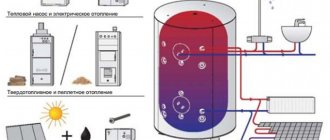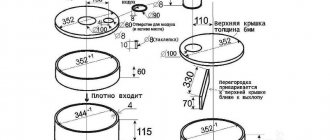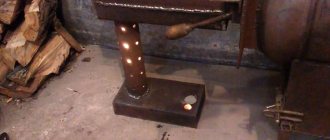The lightweight and easy-to-use metal stove “potbelly stove”, with all its advantages, has one significant drawback: low efficiency.
To heat a room, an ordinary metal potbelly stove usually spends 50-70% of its efficiency, the rest of the heat simply flies out into the chimney.
It is clear that it is very difficult to reconcile with such a situation, but unfortunately, few stove owners take radical measures to increase the efficiency of the furnace. Although, as experience shows, with a little skill and spending a little time you can get a fairly effective stove from this gluttonous design.
How to increase the heat output of a furnace
So, how to increase the efficiency of such a stove?
There are several simple ways. The most basic one is to put a brick screen around the stove. The bricks don’t even need to be held together with clay; just lay them on top of each other. You can fold such a screen near the side walls, or you can fold it at both side and rear walls. The brick will heat up while the fire is burning, and when it becomes small or goes out, it will give off heat. You won't have to add fuel often. One of the features of a potbelly stove is that the stove is light and mobile. With such a screen, it will not lose its mobility, because the bricks can be disassembled at any time, the stove can be rearranged and the screen can be folded in a new place. https://youtube.com/watch?v=SNKEQmQMxl4
There is another method with a screen, which also increases heat transfer. In this case, a sheet metal screen is mounted at some distance from the side and/or rear wall of the stove. The sheets can be secured using long bolts. In this case, the effect of convection is added.
There is another simple way to increase heat transfer. This time the stove's chimney is being modernized. Typically, such stoves have a straight chimney. It is removed through the roof of the room in which the stove is installed. If you add several bends to the pipe, then the heat transfer will increase, although not by much. In this case, the pipe will resemble the letter S.
If you want it to be much warmer, then you need to take 2 tanks from old-style washing machines. The tanks are welded together, and a chimney is passed through them. Thus, above the potbelly stove, which is heated with wood, there is also a stove of the same size, heated by hot smoke. Heat transfer almost doubles.
Another method is to weld additional ribs onto the stove and chimney, for example, from metal angles. In this case, the chimney must be made of thick metal. Such fins significantly increase the heated surface area. An increase in area leads to faster heating of the surrounding air. The room becomes warmer. In addition, thick metal retains heat even when the fire in the firebox is no longer burning.
But still, it will not be possible to endlessly increase the efficiency of this heating device. And if you want to have a full-fledged stove in the room, you will have to build it out of brick according to all the rules, so that the stove retains heat for a long time, for example, all night. For example, there is no need to increase the efficiency of a Russian stove; it already retains heat for a very long time. True, in order to fold it correctly, you will have to call a stove specialist.
Therefore
Installing a potbelly stove in a garage follows the rules. To reduce the risk of burns from hot metal, you can build a brick casing around the unit. It is recommended to cover the walls next to the potbelly stove with brickwork or sheet metal with asbestos lining. Also, a sheet of metal on a fireproof lining is placed in front of the stove.
Time does not stand still, everything changes - and now the designers have already reached the potbelly stove. Its updated look can harmoniously fit into and even embellish a room in an elite mansion.
We are more concerned about the question not of aesthetics, but of practicality: how to make a potbelly stove yourself, what is required for this? This article will help anyone who is planning to make this type of useful heating device on their own.
Ways to increase efficiency
Potbelly stoves are made in various shapes and sizes. But they have one drawback in common - low efficiency. More than half of the thermal energy, in the literal sense of the word, flies out into the chimney. The irrational use of heat has led to the fact that the owners of these heating devices began to think about possible changes in the design of the furnace to increase its efficiency. The solution to this problem could be a partial modernization of the potbelly stove. There was no single concept for solving this issue, and each stove owner began to solve the problem independently, by trial and error.
Increasing the efficiency of a potbelly stove means receiving additional heat from the heating device while maintaining a constant amount of burned fuel. This can be achieved in several ways:
- changing the heat transfer surface,
- increase in heat removal;
- using more high-calorie fuel;
- increasing the heat capacity of the furnace.
The potbelly stove gives off heat to the surrounding space not only with its body, but also with its metal chimney. You can increase the heat transfer surface of the device by revising its dimensions upward. This option is possible when creating a stove with your own hands. Having already made a potbelly stove, you can do it in another way. Usually a corner is welded to a chimney made of a metal pipe. Position it with its apex facing the element along its entire length. The angle is installed around the pipe. Thus, the area of the heat transfer surface can be increased by 3-4 times, depending on the size of the corner.
Another option for increasing the heat transfer surface is to make a chimney running inside a large area. For this purpose, a chimney with turns is made. They are performed in the form of smooth transitions. It is undesirable to create turns at right angles, as the potbelly stove may start to smoke. The last section of the chimney is installed vertically. A pocket is made on it with a hatch for cleaning soot.
If it is impossible to lengthen the pipe, its design is changed. Cylinders made of pipes with a diameter of 300-400 mm are welded onto the pipe coming out of the furnace body. They are connected to each other by pipe sections with a diameter no less than that of the smoke pipe. They are welded out of alignment to increase the smoke path.
Guide to making a potbelly stove
By placing a DIY potbelly stove in your garage, you can improve the heating of the room if you wish. To do this, a water jacket is mounted on the chimney or casing of a rectangular stove, connected to the heating circuit with heating appliances. This option is practiced if the garage has a large area and is electrified - voltage is required for the circulation pump to operate.
Let's take a closer look at how to make simple versions of a potbelly stove - a box stove and a heating unit from a can.
Box model
To make a box stove, you will need sheet steel with a thickness of at least 4-5 mm, a pipe for the chimney pipe, reinforcing bars for making a grate or a sheet of heat-resistant steel. For the legs, use a corner with a suitable shelf size. You will also need hinges for hanging doors and a cast iron burner if you want to create a practical hob.
At the preliminary stage, it is necessary to prepare drawings indicating all dimensions. The dimensions of the box stove are selected depending on the size of the garage - a spacious room requires a more powerful unit.
It is necessary to mark the sheet metal in accordance with the drawings and cut out the parts. Then the stove body is welded in the form of a box without a bottom.
Plates are attached to the upper part of the body, forming a labyrinth through which hot gases will pass on the way to the smoke pipe. This increases the heat transfer of the heating unit and increases the efficiency of the hob.
Increasing heat capacity
The heat capacity of a potbelly stove can be increased both by increasing its weight and dimensions and by using additional heated materials. In any case, it is necessary to make design changes to the heating system. One option may be to use smoke circulation inside the oven. This can be done by installing sheets of heat-resistant metal in the firebox, thereby providing additional paths for the movement of gases. At the same time, they are burned, heating the furnace to a higher temperature. But at the same time, the temperature of the exiting smoke also increases. With a short chimney, the heat is simply released into the atmosphere.
To use this heat, a heat-storing container is installed on the exhaust pipe of the potbelly stove, which can be made either from an old gas cylinder or from a large-diameter pipe. The container is filled with large stones that retain heat well. At the same time, it is loaded to approximately 2/3 of the volume. The stones are placed on the grate. Hot gases flowing through the battery heat them up and, giving off heat, go outside.
The stones are heated to a temperature of about 400 °C. After the fuel burns out in the stove, the damper on the chimney is closed and the room is heated using the heat accumulated by the stones. In this case, the stove is in a cold state. Using such a battery allows you not only to save fuel, but also to receive heat after the stove stops working.
The battery, which increases the efficiency of the furnace, can be made of brick and installed on metal supports above its surface. But such a design cannot be used with a round stove.
The calorie content of fuel depends on its type and quality. Replacing fuel with a higher-calorie fuel is expensive and requires additional storage space. As a rule, garages are heated with waste material that is easy to find. Now, knowing how to increase the efficiency of a potbelly stove, you can begin work. It should be noted that the best results are obtained with the integrated use of methods that increase the heating efficiency of the furnace.
Varieties of potbelly stove
There are many variations of the potbelly stove type stove design. Therefore, it will not be difficult to choose exactly the model that is ideal for a specific room: it will have a set of appropriate technical parameters, as well as satisfy its appearance. To make a potbelly stove, you can take any available material, be it a metal tank or a medium-diameter pipe, a barrel, an old gas cylinder, or sheets of iron with a thickness of at least 3 mm. The main thing is that the material is durable, with reliable walls.
As for heating a garage, any type of potbelly stove is suitable, but in a residential area, some models will be inappropriate.
We invite you to consider several types of potbelly stoves, their features, and methods for making them yourself. So, you can make the right choice in favor of the model you like.
Furnace characteristics
Each device has its pros and cons during use. In the case of a potbelly stove, we highlight the following positive aspects:
- The design of the furnace is simple and does not require large financial expenditures. Everything you need to make a stove with your own hands can be easily found in the utility room.
- If necessary, the potbelly stove can be easily transported to another house or garage. Its weight usually does not exceed 30 kilograms and its small dimensions will only be a plus.
- The stove can be quickly heated regardless of weather conditions.
- In fact, almost anyone can heat a potbelly stove. That is, it can be coals, sawdust, firewood branches, or even household garbage.
As for the negative characteristics, we highlight the main ones:
- The heated surface area is quite small, and therefore a small amount of heat enters the room.
- The room, even after using the stove for a long time, cools down quickly.
Taking into account such shortcomings, we are talking about a low efficiency, that is, the level of efficiency of the stove.
We recommend: How to make a convenient smokehouse yourself
Why do you need furnace modifications?
Every model, and not just stoves, is imperfect, and you always want more and better. So it is in this case with heating partings. Any modifications are carried out in order to obtain maximum effect without reducing the service life of the heating device.
For example, with the help of improvements, you can achieve maximum proper combustion, with a good level of heat transfer, without heating the potbelly stove to the limit so that the metal turns red.
Watch the air damper. It must be at a level so that the flame does not enter the chimney. The fire should not exceed the level of the top of the stove. The heat must be distributed evenly throughout the device in order to properly warm the room.
There are many options for modification; you should choose the optimal one for yourself in order to ensure a comfortable temperature for being in the room.
Ways to increase efficiency
The designs and diagrams of finished furnaces do not provide for modes with variable efficiency. It all depends on proper operation, as well as the ability to independently upgrade the design. There are three simple ways to increase the efficiency of wood-burning stoves: installing a steel pipe in the ash pit, a metal rod in the chimney, or transferring heat from the tiles through the hood back into the room. Each of the methods for improving efficiency indicators is discussed below.
By the way, you can combine them with each other, then the efficiency of the stove will increase even more.
Installation of a steel pipe in the ash pit
If a wood stove is the only way to heat the room, then the air temperature in the room will continue to decrease for the first 40 minutes after ignition. Moreover, such a decrease will be more intense than after turning off the stove. The reason is the open vent, through which the rarefied warm air of the room is sucked into the smoke exhaust ducts.
As the stove heats up, air will flow through the view in the same quantity, but due to the sufficiently heated walls of the stove, heat transfer will begin to prevail. But is it possible to speed up this stage and thereby increase efficiency by 10-15%? You can - to do this, when laying it in the ash pit, install a steel pipe with a damper. As a result, when the view is opened, much less warm air is sucked in (it will be drawn not from the room, but from under the floor).
It is important to remember: the described method of increasing the efficiency of a wood-burning stove has a drawback - the chimney draws air from under the floor, so it will cool down quickly. Walking on a frozen floor is unpleasant
To fix this, you can attach a rubber extension with a diameter of 50 millimeters to the end of a steel pipe, then take it outside the wall of the house (then the ash pan will draw in street air).
Install a steel pipe into the chimney
A well-known fact: very hot air is exhausted through the chimney. Moreover, the longer the stove is heated, the less heat will be removed from the brickwork of the chimney and the hotter the evaporated smoke will be. Consequently, due to intensive operation of the furnace, the efficiency will decrease. People have come up with a trick that helps them use the heated air of the chimney to their advantage and prevent the efficiency from decreasing (such a modification is not found anywhere in finished projects).
The essence of modernizing a wood stove is as follows:
- Take a round metal pipe with a diameter of 20-30 cm.
- The pipe is inserted into the chimney elbow at a slight angle.
- If the stove is large and has several smoke exhaust pipe bends, you can insert 3-4 metal pipes.
- The thermal conductivity properties of the metal ensure that heat is removed from the chimney. This heat does not go outside, but returns back into the room.
As a result, due to such simple modifications, a stove with high efficiency is obtained (the efficiency will increase by 15-20%). Warming up the room will be 2 times faster, and fuel consumption, on the contrary, will be reduced.
The only difficulty: modification of the stove with a homemade and simple heat exchanger can only be carried out at the time of laying the chimney. If you need to improve the efficiency of an already installed stove, the chimney will have to be disassembled and then reassembled.
Additional heat extraction from the stove
The heat emitted from the cooking surface of the stove can be redirected back into the room, thereby increasing the rate at which the house warms up. This process is called recycling. As a result, fuel consumption will decrease and efficiency will increase.
This simple upgrade is done as follows:
- A stainless steel hood is made above the stove surface (not close to avoid overheating).
- A quickly heated pipe (cross section 8-10 centimeters) is connected to the hood. For example, the material for it can be galvanized steel.
- The metal base of the tubular outlet must be at least 1 meter long. Further, it is allowed to be fastened with PVC pipes.
- The pipe should be stretched under the ceiling and brought to the coldest part of the room. It is recommended to supplement the design with small fans (a device with a power of 13 watts is sufficient).
Hood on stove
There are no obvious disadvantages to the described method of increasing efficiency. The only inconvenience: when you turn off the stove, the installed tube will stop conducting heat and the indicators will return to their original values.
As an option: you can install filters (anti-grease and carbon) in the hood. Then the air from the stove will be cleared of the odors of food being cooked on the stove (you will get a simple version of an air conditioner, only without discharging warm air through the ventilation shaft outside the house).
Model No. 1 – potbelly stove using waste oil
I would like to immediately note that this design is not suitable for use in a residential area where people are constantly present. Why? The fact is that during operation, during the combustion of waste oil, a specific aroma is released, and arranging a good exhaust hood will not help.
Materials
To create this option, the following types of material are required:
- metal sheet, several pieces, 5 mm thick. We will make all the parts and blanks from them.
- Pipes for making some structural elements.
- Pipe under the chimney.
Process of creation
The drawing below of the potbelly stove shows all the necessary parts, indicating their sizes.
So, we will divide all the work on creating a potbelly stove using waste as a raw material into successive steps:
- We mark all the necessary parts on a sheet of metal, and then cut them out using a grinding machine. The edges of the resulting workpieces must be thoroughly cleaned.
- We take a pipe of the required length and drill round holes in it. In the future, this pipe will be used to connect the upper and lower containers of the stove.
- We take the top tank and cut an opening of the required size on top. This opening will not be located in the center, but will shift to the left of it. We prepare this hole for the chimney pipe. From the bottom side we cut out an opening, shifting it to the right. It will serve as an entrance for the connecting pipe.
- We weld two circles to the part of the pipe that determines the thickness of the upper container.
- We will do the same with the bottom of the stove. But now we will cut the opening for the incoming connecting pipe in the center of the container. In addition, we need to cut another hole - a neck through which we will fill the stove with fuel. We provide a sliding cover for this hole.
- We weld 3-4 legs on the back side of the lower tank. This will ensure stability.
- To give rigidity to the structure and strengthen it, we connect both tanks to each other using metal brackets.
- The main work points are completed, it's time to think about beauty. We carefully clean the welds, and then paint the stove using heat-resistant paint. Painting the stove will also protect it from premature rusting.
- The last step is installation of the chimney pipe.
Principle of operation
The operation of this type of potbelly stove can be described as follows: pour waste oil into the lower container through the neck. Next, using a torch or paper, ignite the fuel through the opening. As soon as the oil raw material flares up in the tank, close the hole with the sliding lid.
The combustion process is enhanced by air entering the connecting pipe through the holes made. The air is heated and rises through the pipe to the upper part of the structure, while heating the surface of the container so that the kettle can easily be warmed on it. The big advantage of this model of potbelly stove is that there will be no unpleasant situations with a lack of fuel, since motorists always have used oil in the garage.
Why you can’t extinguish boiling oil, fat, paraffin with water. If you use a stove during work, you must have a fire extinguisher and sand.
Calculation of basic parameters (with drawings and dimensions)
High efficiency of a potbelly stove can only be achieved if all the main design parameters are correctly calculated.
Pipe
In this case, the diameter of this element is very important. The throughput of the chimney should be less than the productivity of the furnace firebox, which is the main distinguishing feature of a potbelly stove. This will allow warm air not to immediately leave the stove, but to linger in it and heat the surrounding air.
It is very important to make an accurate calculation for it. The diameter should be 2.7 times the volume of the firebox. In this case, the diameter is determined in millimeters, and the volume of the firebox in liters
For example, the volume of the combustion chamber is 40 liters, which means the chimney diameter should be about 106 mm
In this case, the diameter is determined in millimeters, and the volume of the firebox in liters. For example, the volume of the combustion chamber is 40 liters, which means that the chimney diameter should be about 106 mm.
If the potbelly stove provides for the installation of grates, then the height of the firebox is calculated without taking into account the volume of this part, that is, from the top of the grate.
Screen
It is very important to force the hot gases not to cool, but to burn out completely. In addition, the fuel must burn through partial pyrolysis, which requires extremely high temperatures. A metal screen located on three sides of the stove will help to achieve a similar effect.
It should be placed at a distance of 50–70 mm from the stove walls, due to which most of the heat will return to the stove. This air movement will give the necessary high temperature and protect against fire.
A metal screen located on three sides of the stove will help to achieve a similar effect. It should be placed at a distance of 50–70 mm from the stove walls, due to which most of the heat will return to the stove. This air movement will give the necessary high temperature and protect against fire.
The screen of a potbelly stove made of red brick is capable of accumulating heat
Litter
It definitely has to be there. There are two reasons for this:
- some of the heat is radiated downwards;
- the floor on which the stove stands gets hot, which means there is a risk of fire.
The litter solves these two problems at once. As such, you can use a metal sheet with a projection of 350 mm (ideally 600 mm) beyond the contour of the furnace itself. There are also more modern materials that do an excellent job of this task, for example, a sheet of asbestos or kaolin cardboard, at least 6 mm thick.
You can use an asbestos sheet for bedding under a potbelly stove.
Chimney
Despite all the calculations, gases sometimes escape into the chimney not completely burned out. Therefore, it must be done in a special way. The chimney consists of:
- the vertical part (1–1.2 m), which is recommended to be wrapped in thermal insulation material;
- hog (slightly inclined part or completely horizontal), 2.5–4.5 m long, which should be 1.2 m from the ceiling, which is not protected with heat-resistant materials (1.5 m from the wooden surface), from the floor - by 2.2 m.
The chimney must be vented to the street
Photo gallery: diagrams of a potbelly stove for a garage
The diagram must indicate all the exact measurements. The chimney must be led out onto the street. The potbelly stove can be round or square. The volume of the firebox depends on the presence of grates. The layout of the potbelly stove depends on the material used.
Do-it-yourself wood-burning garage oven: safety rules
A self-made potbelly stove for a garage must first of all be safe. When using it, the following rules must be observed:
- the floor and walls around the stove must be made of refractory material : tiles, iron, plaster, brick. It is permissible to cover the walls with special plasterboard;
- flammable objects or substances near the stove
- the stove can only be built from proven quality materials;
- the garage must be equipped with a ventilation .
A DIY garage wood stove Therefore, ventilation of a garage equipped with a potbelly stove is extremely important for two reasons:
- if there is a lack of oxygen, the fire in the stove will go out or burn weakly;
- Excess carbon dioxide indoors can cause poisoning or death.
To remove combustion products from the garage, it is necessary to install a chimney , but if problems arise in the pipe, ventilation will prevent the garage from catching fire or poisoning the people in it.
The necessary access to fresh air can be ensured by leaving a small (up to 5 cm) gap under the gate or by making several ventilation holes under the roof.
Do-it-yourself wood-burning stove for the garage:
Selecting a location
It is best to install a potbelly stove in the corner of the wall opposite the gate. The heat emanating from the far corner will warm the room and remain in the garage even when the door is opened. The distance from the wall to the stove can be about 0.5 m if the walls are made of brick, iron or any non-combustible material. With wooden walls, it is better to move the stove 1 m and cover the walls with bricks, tiles or cover them with a steel apron.
An iron sheet is placed underneath the stove or the floor surface is cemented within a radius of 1-1.5 m. Thanks to this, coals that accidentally fall out of the stove or flying sparks will cool down without causing a fire in the garage.
Brick walls lined on the sides and end of the stove increase safety and increase the heat transfer The slowly cooling brick will maintain the temperature in the garage for several hours after the furnace has finished firing.
brick a square or rectangular stove yourself Incorrectly covering a cylindrical potbelly stove with stone can lead to a reduction in heat transfer to the room and rapid burning of the metal walls of the stove. increase the heat transfer of a furnace made from part of a pipe by welding metal ribs to its sides.
The dimensions of the potbelly stove for the garage are:
- height 50 cm (body 30 cm and legs 20 cm);
- width 30 cm;
- length 50 cm.
When making a potbelly stove from a metal pipe, the diameter of the latter must be at least 30 cm. For any stove shape, the minimum metal thickness is 5 mm.
Do-it-yourself wood-burning stove in the garage - drawings:
Fuel reserve
Firewood is the most popular fuel for garage stoves. They allow you to quickly warm up a room and are inexpensive (or you can prepare them yourself, i.e. get them for free).
For a potbelly stove , well-dried (preferably aged for more than a year) firewood, sawn 25 cm long and stored in a ventilated place protected from precipitation, is suitable. A shed is ideal for storing firewood , but you can also store it under a canopy. When choosing fuel , it is worth considering that different wood produces different amounts of heat:
- pine, spruce and larch burn out quickly and provide little heat;
- oak, birch, acacia, pear, apple, cherry and maple have greater density, burn slower and give more heat.
In addition, when burning coniferous trees, a lot of soot , which settles on the chimney and creates a fire hazard. Burning birch is no less dangerous - the released tar mixes with soot and settles in the pipes and on the walls of the firebox.
The most dangerous fire method is burning coniferous or birch wood in smoldering mode. Resins and tar settle on the pipes and impregnate the brick; it is impossible to clean them off mechanically.
It is advisable to stock up on firewood a year or two before use. Delivery can be ordered online or through advertisements in local newspapers. But you can stock up on firewood for free:
- in forest areas, obtain permission to cut down trees in a certain area (you will need to collect documents and spend time visiting authorities);
- collect dry trees and large branches fallen by the wind in groves, forest belts and courtyards;
- go to the nearest sawmill , where wood waste is burned or allowed to be picked up by those who wish (you may need a small remuneration for workers);
- find an area where furniture factories are cutting down forests - branches, tops and root parts of trees remain in place, which can be cut down and taken away.
What is furnace efficiency?
- What affects efficiency?
- Ways to increase efficiency
- Installation of a steel pipe in the ash pit
- Install a steel pipe into the chimney
- Additional heat extraction from the stove
- Conclusion
Of course, a lot depends on the design of the heating system (this will be discussed in more detail in the next chapter). But there are also external factors:
- The quality of the fuel used is of great importance. The efficiency of a wood-burning stove will drop by 3 times if it is heated with raw material.
- Efficiency depends on the completeness of fuel combustion; this is affected not only by its quality, but also by air humidity, room temperature, and atmospheric pressure.
- Operating mode. If a person constantly keeps the firebox door open, one can only dream of high efficiency.
It becomes obvious that the efficiency factor is not a strictly fixed indicator. It can be reduced if the stove is used incorrectly, or the design can be improved by significantly increasing the efficiency parameter.
Modernization methods
The design features of the stove do not allow for major changes, of course, unless you decide to make a small home nuclear reactor out of it, but all the proposed improvements are aimed at only one thing - heat preservation. During operation, the stove easily loses heat through the pipe; the thinness of the walls quickly transfers it, but does not allow it to be stored for a long time. The direct-flow furnace consumes a large amount of fuel, and its properties are aimed at consuming charcoal raw materials.
To modernize and increase efficiency, it is to obtain the greatest amount of heat with the same fuel combustion.
There are four main and simple methods for upgrading a potbelly stove, the use of which will significantly reduce heat loss:
- Attaching 2 tanks welded together from a washing machine.
- Making an ash pit.
- Grid with stones.
- Increasing the number of pipe bends
Let's take a closer look at them.
Types of homemade long-burning stoves
For heating small rooms, brick or metal stoves (potbelly stoves) can be used, capable of operating on both solid and liquid fuels.
Long-burning brick stoves are rarely built, since not everyone is able to lay them out with their own hands, taking into account the special requirements for the material and design of the chimney.
After all, an incorrectly made chimney pipe will result in continuous problems with insufficient draft and smoke in the room. In addition, purchasing fireclay bricks and the same powder for mortar will require a lot of money. And the brick oven itself takes up a lot of space, which is completely unacceptable for premises such as a garage, small country house or greenhouse.
Metal stoves, called potbelly stoves, can use free fuel in the form of waste oil, which does not require further disposal and brings tangible benefits.
Pros and cons of homemade long-burning potbelly stoves
Now that the basic designs of furnaces with an extended fuel combustion period are known, it is necessary to analyze the positive qualities and disadvantages of these devices.
The positive aspects include:
- Significant fuel savings;
- High heat transfer;
- Ability to work in “offline” mode for a long time;
- Possibility of use for most types of different fuels.
Alas, these designs also have disadvantages that cannot be called insignificant:
- The need for a hermetically sealed connection of all parts of the housing during assembly;
- High requirements for keeping chimneys clean;
- Despite the fact that the stoves are designed for a long period of operation, they must be looked after periodically;
- To use such devices, certain skills and abilities are required;
- To assemble such a stove yourself, you need to have fairly high skills in metalworking;
- To use, you need well-dried firewood.
How to increase the heat output of a furnace
So, how to increase the efficiency of such a stove? There are several simple ways. The most basic one is to put a brick screen around the stove. The bricks don’t even need to be held together with clay; just lay them on top of each other. You can fold such a screen near the side walls, or you can fold it at both side and rear walls. The brick will heat up while the fire is burning, and when it becomes small or goes out, it will give off heat. You won't have to add fuel often. One of the features of a potbelly stove is that the stove is light and mobile. With such a screen, it will not lose its mobility, because the bricks can be disassembled at any time, the stove can be rearranged and the screen can be folded in a new place.
https://youtube.com/watch?v=SNKEQmQMxl4
There is another method with a screen, which also increases heat transfer. In this case, a sheet metal screen is mounted at some distance from the side and/or rear wall of the stove. The sheets can be secured using long bolts. In this case, the effect of convection is added.
There is another simple way to increase heat transfer. This time the stove's chimney is being modernized. Typically, such stoves have a straight chimney. It is removed through the roof of the room in which the stove is installed. If you add several bends to the pipe, then the heat transfer will increase, although not by much. In this case, the pipe will resemble the letter S.
If you want it to be much warmer, then you need to take 2 tanks from old-style washing machines. The tanks are welded together, and a chimney is passed through them. Thus, above the potbelly stove, which is heated with wood, there is also a stove of the same size, heated by hot smoke. Heat transfer almost doubles.
Another method is to weld additional ribs onto the stove and chimney, for example, from metal angles. In this case, the chimney must be made of thick metal. Such fins significantly increase the heated surface area. An increase in area leads to faster heating of the surrounding air. The room becomes warmer. In addition, thick metal retains heat even when the fire in the firebox is no longer burning.
But still, it will not be possible to endlessly increase the efficiency of this heating device. And if you want to have a full-fledged stove in the room, you will have to build it out of brick according to all the rules, so that the stove retains heat for a long time, for example, all night. For example, there is no need to increase the efficiency of a Russian stove; it already retains heat for a very long time. True, in order to fold it correctly, you will have to call a stove specialist.
Drip potbelly stove under development
You can also make an economical model of a drip stove yourself. For the body, a small metal barrel or another container available on the farm is suitable. A hole is made in the housing through which oil will flow.
Next, take a burner with a capacity of about 2 liters, connect a 1 m long copper tube to its hose, and then fold it in half.
Such a unit, operating on waste petroleum products, can smoke, so the room in which it is installed must have good ventilation
A hole is made in the container along the diameter of the tube. The tube itself is shaped like the letter “L”, and the burner is suspended.
Why modernize?
The potbelly stove is a very simple heating device, although today it is deeply modernized. Such a stove, which has become a favorite solution for heating small country houses, can have not only a single-chamber, but also a two-chamber design. A modernized potbelly stove can provide heat even to houses where residents live permanently.
The simplicity of design and manufacture makes it accessible to purchase and use. In addition, a significant advantage for the construction of such a structure is the absence of a foundation. But, despite so many positive properties, the potbelly stove also has significant disadvantages:
- Its efficiency is quite small, the simplicity of the design carries with it an inherent drawback - a huge part of the heat from the potbelly stove “flies into the chimney”.
- To work with such a stove, strict safety requirements must be observed, since falling combustion elements can damage nearby premises and even lead to a fire.
- To heat a room with a potbelly stove, it is necessary to consume a significant amount of fuel elements, which is due to the fact that this type of heating is used only for short-term operation.
But this is not a reason to be discouraged; over the years, our “Kulibins” have found several simple but effective ways to increase the efficiency of a potbelly stove. In this article we will look at the modernization of the stove design itself.
Why increase efficiency?
The compact dimensions of the stove mean that the surface that heats up during operation is small. Not much heat flows outside and the room quickly cools down. Sometimes it seems that the return from the potbelly stove is weak.
To help it increase efficiency, several tasks are solved:
- the duration of combustion and smoldering increases;
- a sufficiently high combustion temperature is ensured;
- a high level of traction is achieved.
Standard potbelly stove efficiency
We can talk about the efficiency factor in relation to a potbelly stove in a conditional manner. This parameter is approximately 65-70%.
Rules for safe installation of a metal stove
A potbelly stove heats up much hotter than a brick stove, so all flammable objects should be kept at a sufficient distance from the stove. If the floor in the room is wooden, it is installed only on bricks or metal sheets. The metal, in turn, is laid on an asbestos sheet with its removal 35 cm or more from the edges of the stove. In the front part in front of the firebox it should protrude 5.5 cm. Asbestos can be replaced with felt impregnated with clay. You can also install such a screen to reflect heat on concrete.
Important! A working oven requires supervision. You should not leave the room where the potbelly stove is heated for a long time.
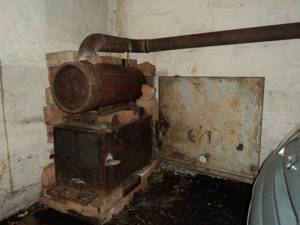
Installing a potbelly stove on a brick base
How to improve oven performance
This stove has one significant drawback - it cools down very quickly. However, this is very easy to fix with the help of a brick screen, which is installed on three sides of the structure. This will allow you to accumulate heat and release it to the room even after the stove stops burning.
It should be placed at a distance of 5–7 cm from the walls of the stove, and in no case end-to-end. In this case, you need to take care of the presence of ventilation holes.

The screen should not be close to the walls of the stove
A structure with a brick screen will weigh much more than a conventional metal stove, so it is recommended to first build an individual foundation.
In some cases, it may be necessary to install a custom foundation. It's very easy to do:
- Dig a hole about 50 cm deep. All other dimensions depend on the size of the stove itself and the screen.
- Fill the bottom of the hole with sand (usually this takes about 3-4 buckets), after which it needs to be compacted. Cover the sand with a 10–15 cm layer of crushed stone and compact it as well.
- Level the backfill and fill it with prepared cement mortar. Leave it for a day (you can do it for several days, the foundation will only benefit from this).
- Cover the base with several layers of roofing felt.
- Now you can start laying out the screen in the brick floor. In this case, the first two rows should be laid out in continuous masonry directly on the roofing material. In rows 3–4 it is necessary to make ventilation gaps. Continue solid masonry.
- It is recommended to make the screen without a top covering.
Ensuring heat removal
It is possible to increase heat removal by creating devices that promote natural and forced convection. To ensure natural air circulation, screens are made with a guide device that allows you to create a powerful convection flow and distribute it throughout the room. The guide apparatus is made in the form of curved strips of metal, welded to the screen and directing warm air not only upwards, but also to the sides. The prepared device is attached to the oven.
The heat removal device can also be made from scraps of water supply and profile pipes. The distance from the floor to the bottom edge of the elements must be at least 15-20 cm. The pipes are welded to the stove body and covered with a screen on the sides to protect against accidental contact. A traditional potbelly stove heats the air around it by 0.5-1.0 m, and the use of such a design allows you to increase not only the radius, but also the rate of temperature rise in the room. When the body of the heating device is heated above 60 °C, a stable convection draft appears in the device, the power of which increases as the temperature of the furnace increases.
Heat removal can be increased by using fans to blow over the heat transfer surface. Both household and old car fans are used. Devices with variable rotation speeds have proven themselves especially well. They allow you to regulate the temperature and heating time of the room in various oven operating modes.
For more efficient blowing of the furnace elements, special casings are installed that allow cold air to be directed to the hottest areas of the heating device, while it can be taken from various places in the room. A potbelly stove with pipes welded into the firebox for heating air has proven itself well. A multi-speed car fan installed on a common discharge manifold allows you to effectively heat the room.
The combined use of devices for artificial airflow and natural convection can significantly increase the efficiency of a potbelly stove, which means heating the room more efficiently.
Potbelly stove stove design
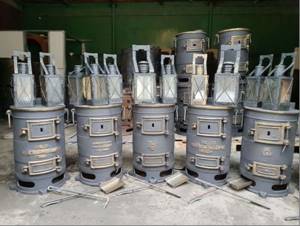
Conventionally, the model of a potbelly stove can be imagined as a hearth wrapped in metal and slightly raised above the floor level. Classic cast iron stoves have a firebox and a blower. The design does not provide a gate to regulate the air supply to the combustion chamber, so this is done by opening and closing the blower door. Such an operation is unsafe - when the ash pit is filled with ash, sparks often roll out, which causes a fire. So the “potbelly stove” fully lives up to its name and the appetite is exorbitant and a fire can break out at any minute. The fuel combustion process also looks specific, which is the reason for the low efficiency of the potbelly stove. When wood burns, the metal shell of the stove body heats up and the heat spreads into the room through thermal radiation. The burning of wood usually occurs irrationally; when burning, the wood simply does not have time to reach the required temperature and therefore some of the combustible gases from the firebox simply go into the chimney. By the way, the pipe itself, like the furnace body, wastes precious heat irrationally - heating of the room occurs due to thermal radiation, and occurs only when the fire is burning in the firebox. As you can see, everything is quite simple - the fuel burns inefficiently in the firebox, while this type of heat energy release such as convection is used irrationally. So it turns out that any improvement immediately allows you to increase the efficiency of the potbelly stove, which means it will allow you to use fuel more efficiently.
Requirements for the construction of potbelly stoves
An economical, long-burning wood-burning stove must meet certain requirements and design rules:
- It is mandatory that such a structure is equipped with a smoke exhaust pipe, and the room is equipped with a supply and exhaust ventilation system.
- Considering that the design of a potbelly stove will heat up to very high temperatures when heated, it is necessary to comply with fire safety requirements when installing it indoors.
The stove should be located away from flammable structures of walls, ceilings and floors, and also have a fence to prevent fire and the risk of burns during its operation. A potbelly stove surrounded by a wall made of heat-resistant brick not only becomes safe during operation, but also creates additional heating areas.
What types of fuel can be used
When it comes to the heating system for a temporary premises, such as a workshop or garage, two aspects are usually taken into account - economic feasibility and safety. In terms of economic feasibility, the most affordable type of fuel today is wood. Liquid fuel, such as diesel fuel or used engine oil, is used for heating mainly utility rooms; in residential areas, the use of this fuel is limited because it has a specific odor. Coal is usually not used for long-burning furnaces of handicraft production; it is intended for heating boilers and stationary brick furnaces.
Thus, the most acceptable type of fuel is firewood or pallets - fuel from wood processing waste. And here lies the whole secret of long-burning furnaces. The fact is that to get maximum effect you need to use only dry firewood. In ordinary, freshly cut firewood, the wood contains a large amount of moisture; during combustion, it turns out that two processes occur in parallel - burning of wood fibers and drying, releasing a large amount of water vapor. The result is a large amount of unburned fuel and combustion at a low temperature. These processes do not allow obtaining the maximum amount of heat.
It's a different matter with dry firewood. The moisture content in them is minimal, which means that when the temperature rises to 300 degrees, the process of decomposition of wood into simple substances begins. This allows you to significantly increase heat transfer, as a result of which the firewood burns completely with minimal formation of soot and ash.
The third type of stove-stove
Now let’s figure out how to construct a homemade potbelly stove with a square body with thin walls and an adjustable draft. The main advantage of a square-shaped potbelly stove is its larger surface area of interaction with air, that is, greater efficiency compared to a stove based on a pipe.
The most optimal dimensions for a homemade stove will be a structure height of 800 mm and a base of 450 × 450 mm. A potbelly stove of this size will not take up much space and can easily accept almost any piece of wood.
Chimney installation diagram.
You should also determine what thickness of metal will serve as the material for the stove. Here, as in everything, a golden mean should be observed: very thick walls (about 1 cm) take too long to warm up, thin-walled metal sheets swell after heating, and the stove will become shapeless.
For these purposes, choose an average wall thickness - approximately 0.3-0.5 cm. Then the potbelly stove will retain its original appearance and will perfectly warm the room.
Rocket stove with a cylinder for combustion of exhaust gases
The conventional lightweight rocket stove is quite easy to recognize from photographs due to its unusual design. Three round or square pipes welded at one point and having a common internal space are perhaps the simplest design for a camp fireplace.
But, like an ordinary cast iron stove, the rocket has a very large appetite. On the other hand, the rocket furnace simply has enormous heat transfer from the fuel; it is not for nothing that this design is recognized as the most efficient compared to other projects.
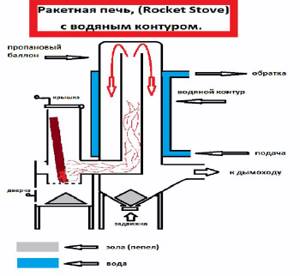
It is this property of rocket-like emission of flame that is used in the design of long-burning potbelly stoves with a cylinder. The fact is that the flame coming out of the firebox is used ineffectively. The video of the operation of such a furnace shows that the flame comes out with great pressure. But along with the flame, a large amount of unburned gases also comes out. The idea of using this potential is to install a large cylinder after the rocket furnace, with the entrance window located on one side and the exit window on the other.

The flame with unburned combustion products, entering the cylinder, continues to burn until complete splitting. Thus, further combustion of flammable gases occurs in the cylinder itself, and smoke and other combustion products are removed through the outlet window.
Ways to increase efficiency
Potbelly stoves are made in various shapes and sizes. But they have one drawback in common - low efficiency. More than half of the thermal energy, in the literal sense of the word, flies out into the chimney. The irrational use of heat has led to the fact that the owners of these heating devices began to think about possible changes in the design of the furnace to increase its efficiency. The solution to this problem could be a partial modernization of the potbelly stove. There was no single concept for solving this issue, and each stove owner began to solve the problem independently, by trial and error.
Increasing the efficiency of a potbelly stove means receiving additional heat from the heating device while maintaining a constant amount of burned fuel. This can be achieved in several ways:
- changing the heat transfer surface,
- increase in heat removal;
- using more high-calorie fuel;
- increasing the heat capacity of the furnace.
The potbelly stove gives off heat to the surrounding space not only with its body, but also with its metal chimney. You can increase the heat transfer surface of the device by revising its dimensions upward. This option is possible when creating a stove with your own hands. Having already made a potbelly stove, you can do it in another way. Usually a corner is welded to a chimney made of a metal pipe. Position it with its apex facing the element along its entire length. The angle is installed around the pipe. Thus, the area of the heat transfer surface can be increased by 3-4 times, depending on the size of the corner.
Another option for increasing the heat transfer surface is to make a chimney running inside a large area. For this purpose, a chimney with turns is made. They are performed in the form of smooth transitions. It is undesirable to create turns at right angles, as the potbelly stove may start to smoke. The last section of the chimney is installed vertically. A pocket is made on it with a hatch for cleaning soot.
If it is impossible to lengthen the pipe, its design is changed. Cylinders made of pipes with a diameter of 300-400 mm are welded onto the pipe coming out of the furnace body. They are connected to each other by pipe sections with a diameter no less than that of the smoke pipe. They are welded out of alignment to increase the smoke path.
Increased utility
Potbelly stoves can come in a variety of sizes and shapes. They are invariably connected by one fact - low efficiency. Thermal energy does not enter the desired room, but flies away into the chimney. Therefore, the owners of such stoves decided to experiment with the design to increase utility.
In this case, they often resort to partial modernization of the furnace. There was no single solution for everyone in this matter, so each owner, using his own trial and error, looked for a solution to the problem.
To increase the amount of heat released without increasing the volume of fuel required, you can do the following:
- Improve heat transfer surface
- Increase heat removal
- Change the type of fuel to a higher calorie one
- Increase the heat capacity of a potbelly stove
Option 1
The heat in a house or garage from a potbelly stove comes not only from the outgoing heat of the structure, but also from the metal chimney. Therefore, the heat transfer surface can be increased. This is quite possible when making a stove with your own hands.
We recommend: Self-made electric smokehouse
If you already have a ready-made device, then here’s how to implement the idea. Weld a corner to a metal chimney pipe. You need to position it with its apex facing the entire length of the element, and set the angle along the circumference of the pipe. Using this method, it is possible to increase the heat transfer surface by about 4 times (depending on the size of the selected corner).
You can also resort to the option of making a metal pipe that will pass over a larger area. It is necessary to make a chimney with turns. Turns should be smooth, without right angles, so that the device does not start smoking. The final section of the chimney is made vertical; a compartment is located in the last section to subsequently clean out soot.
When it is impossible to lengthen the pipe, then change its composition. To do this, cylinders with a circumference of about 40 cm are welded onto the pipe, which protrudes from the body of the structure. They are connected to each other by pieces of pipe, the diameter of which is no less than the diameter of the pipe.
Option 2
To modify the stove, you can install side screens. Everything is quite simple, but effective in the end.
Sheets of metal are attached to the side parts of the potbelly stove using self-tapping screws. The metal must be unpainted and of any thickness. The screens are mounted at a distance of 6 cm from the body.
In this simple way, the principle of heat transfer changes. That is, thermal energy enters the room through convection, and not through radiation. The air begins to circulate in the prepared space, which will save on fuel purchases and increase the rate of heating of the garage or house.
Folk way
A curious way to ensure that the heat continues to spread even after the stove is no longer working.
After all the fuel in the stove has already burned out, an iron box is placed on it and two buckets filled with sand are placed on top of it.
This design will allow heat to accumulate, and the garage will heat up for some time without additional fuel.
Ensuring heat removal
It is possible to increase heat removal by creating devices that promote natural and forced convection. To ensure natural air circulation, screens are made with a guide device that allows you to create a powerful convection flow and distribute it throughout the room. The guide apparatus is made in the form of curved strips of metal, welded to the screen and directing warm air not only upwards, but also to the sides. The prepared device is attached to the oven.
The heat removal device can also be made from scraps of water supply and profile pipes. The distance from the floor to the bottom edge of the elements must be at least 15-20 cm. The pipes are welded to the stove body and covered with a screen on the sides to protect against accidental contact. A traditional potbelly stove heats the air around it by 0.5-1.0 m, and the use of such a design allows you to increase not only the radius, but also the rate of temperature rise in the room. When the body of the heating device is heated above 60 °C, a stable convection draft appears in the device, the power of which increases as the temperature of the furnace increases.
Heat removal can be increased by using fans to blow over the heat transfer surface. Both household and old car fans are used. Devices with variable rotation speeds have proven themselves especially well. They allow you to regulate the temperature and heating time of the room in various oven operating modes.
For more efficient blowing of the furnace elements, special casings are installed that allow cold air to be directed to the hottest areas of the heating device, while it can be taken from various places in the room. A potbelly stove with pipes welded into the firebox for heating air has proven itself well. A multi-speed car fan installed on a common discharge manifold allows you to effectively heat the room.
Conversion of a solid fuel stove for testing
When the household already has a potbelly stove, but is not happy with the fact that it runs on solid fuel, you can modernize it and it will become universal. For this purpose, an attachment is made that resembles in its design a stove with processing in its lower part.
There is also a perforated pipe here, but not straight, but bent at a right angle. It is connected to the side wall of the furnace, which serves as the final combustion chamber. If you weld the potbelly stove door and make a hole in it for the pipe to enter, then the stove will only work during exhaust.

The modernization of this stove consists not only of adding a special attachment to it, but also of an original solution to protect nearby objects from fire using the principle of convection. For this purpose, pipes were welded to the side wall of the furnace. Cold air entering them from below cools the structure
To make it possible to use not only industrial oil for heating, but also firewood, two replaceable doors are made. The standard one is hung when it is planned to lay firewood, and the modernized one with the appropriate hole is hung when the stove will operate on waste oil.
We also suggest reading an article on how to assemble a potbelly stove using waste oil from a pipe - to familiarize yourself with the material, follow the link.
How to increase draft in a potbelly stove using a chimney
The design of a high-efficiency potbelly stove chimney should have the following features:
- The chimney should be made high enough. So, the optimal distance from the furnace itself to the top of the pipe is about 5-6 m.
- There should be no horizontal or inclined sections of less than 45 degrees in the pipe shape, or their number should be kept to a minimum.
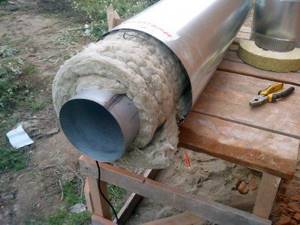
An increase in the efficiency of a potbelly stove will also be facilitated by the creation of thermal insulation on the pipe, which will significantly reduce the damage from the formation of condensation.
- When establishing the cross-section of the chimney, you need to choose the optimal size. If at the time of establishing the efficiency of the potbelly stove there is already a too narrow chimney, you can put a deflector on top, which will protect the structure from precipitation and increase draft.
- The height of the pipe should also be affected by the level of the ridge. If the chimney is lower than it, you need to extend the pipe.
We also recommend studying this topic:
How to make an economical stove-stove with your own hands with increased heat transfer
The history of the invention of the potbelly stove dates back to the 18th century. A potbelly stove has been and remains a cheaper alternative to expensive fireplaces and stoves. The device became most popular during the October Revolution, when heating rooms became quite difficult. Thus, the potbelly stove began to actively spread and gain popularity among the population.
28940 0 0
Tip: The draft force in the stove is determined by the color of the flame: if there is not enough air, it is red with dark stripes, if there is too much air, it is bright white, and the chimney often makes a hum. If the color of the flame is golden-orange, then the potbelly stove’s draft is normal.
Making an ash pit
An ash pan is a grate near a potbelly stove, on which fuel will subsequently be placed to heat the room.
A good ash pan provides the combustion chamber with a sufficient amount of air (that is, oxygen), and also provides good draft, thereby ensuring better combustion. In most cases, ash pans in potbelly stoves leave “much to be desired,” so upgrading the ash pan will help improve the performance of the potbelly stove.
An effective ash pit should be made of heat-resistant material and have a door, thanks to which you can avoid smoke in the room. Improving the ash pan will help turn an ordinary potbelly stove into something like a fireplace.
Materials and tools
- a metal sheet,
- fittings,
- welding machine,
- metal working tool,
- ash door.
Instructions
Making an ash pan yourself will require certain skills from you, and the production must be in accordance with the instructions:
- First you need to weld the box to the size of the potbelly stove, without the top wall and leave a rectangular cutout in the end wall. Steel is most often used in production. The dimensions must correspond to the width and length of the potbelly stove itself.
- Make holes in the bottom of the stove. The diameter of the holes should be about 20 mm.

Drilling holes for the ash pan
- Weld the box to the stove.
- Install the door into the ash pan.
This design will give better and more uniform operation of the potbelly stove.
Using thermal accumulators
When purchasing a boiler, we select its power based on the lowest temperature that can be observed in our region. And in severe frost, the heater operates at rated power, at which the fuel burns optimally. But extreme cold does not reign for long, and the rest of the time the damper has to be closed, reducing heat transfer. In this case, the combustion mode turns from optimal to least profitable.
Owners of Russian stoves are not familiar with this problem: this unit is always heated in the optimal mode, and excess heat is accumulated by the brick mass and then gradually released into the room over a long period of time.
It would be good to apply this tactic to a steel or cast iron boiler, but the walls of such devices do not have sufficient heat capacity. There is only one thing left: to create and connect to the boiler a separate device capable of accumulating heat.
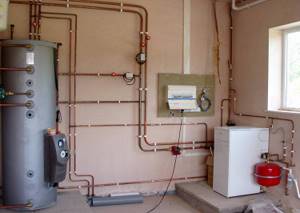
Heat accumulator for heating boiler
At the same time, the volume of carbon monoxide in emissions decreases, and you will need to add firewood or coal much less often. In this case, the possibility of overheating and boiling of the coolant in the boiler heat exchanger is almost completely eliminated.
The heat accumulator will not interfere with the owner of an electric boiler. At night, as you know, electricity costs 3 times cheaper than during the day. If you have a heat accumulator, you can switch to a differentiated tariff and use the electric boiler only at night.

